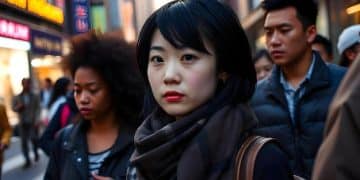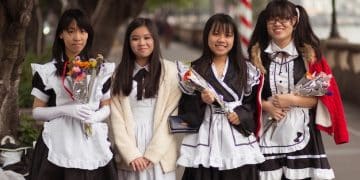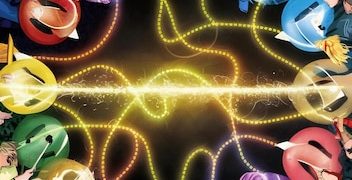J-Drama Romances: A Comparative Analysis of the Best Series

J-Drama romances offer a diverse range of stories, from lighthearted comedies to deeply emotional dramas, providing viewers with unique cultural insights and compelling narratives that explore love in various forms.
Japanese drama, or J-Drama, has captivated audiences worldwide, especially its romance genre. This article offers a J-Drama romances comparative analysis, examining the themes, tropes, and cultural elements that make them unique and appealing.
Popular themes in J-Drama Romances
J-Drama romances often revolve around several recurring themes that resonate with audiences. These themes explore various aspects of love, relationships, and life, providing a rich tapestry of stories.
The concept of fate
Many J-Dramas delve into the idea of destined love, where characters are brought together by fate or predetermined connections. This theme often involves chance encounters, shared pasts, or supernatural elements that emphasize the idea that certain relationships are meant to be.
Overcoming obstacles
Another prevalent theme is the struggle to overcome obstacles in love—characters face social, economic, or personal barriers that test their relationships. These challenges highlight the resilience and determination required to maintain love.
Cultural nuances
J-Dramas subtly incorporate Japanese cultural values, such as respect, duty, and familial expectations, which influence relationship dynamics and character decisions.
- Respect: Characters show deep respect for one another’s feelings and boundaries.
- Duty: Obligations to family and society often play a significant role in romantic decisions.
- Familial expectations: Parental and societal pressures can impact romantic relationships.
These themes provide a foundation for the rich storytelling in J-Drama romances, making them resonate with a broad audience.
Iconic J-Drama Romance Tropes
J-Drama romances use a set of recognizable tropes that heighten emotional impact and create unique viewing experience. These tropes, while sometimes cliched, are often used effectively to explore themes.
Childhood friends
The “childhood friends” trope is common, where the bond between longtime friends. This connection often evolves into romantic feelings, leading to heartwarming or bittersweet romance.
Love triangles
Love triangles are prevalent conflicts when characters find themselves torn between two potential partners. This adds drama and forces characters to confront their true feelings.
Forced proximity
Circumstances, such as living together or working closely, force characters into close proximity, intensifying emotions and leading to romance.
- The tsundere: A character who is initially cold but gradually reveals a softer side.
- The damsel in distress: A protagonist who requires rescue, often challenging traditional gender roles.
- The second lead syndrome: Empathy for the character who doesn’t win the main character’s heart.
These elements can heighten the emotional impact of J-Drama romances and endear characters to viewers.
Comparative Analysis of Popular J-Drama Romance Series
Examining several popular J-Drama romance series provides insights into how typical themes and tropes are presented.
Hana Yori Dango
Hana Yori Dango’s plot revolves around Tsukushi Makino, a working-class girl who attends an elite school dominated by the F4, a group of wealthy and influential heartthrobs. She clashes with their leader, Tsukasa Domyoji, leading to an unlikely love story.
Itazura na Kiss
Itazura na Kiss presents a situation where Kotoko Aihara, a clumsy high school student, declares her love for the intelligent and handsome Naoki Irie. After being rejected, an earthquake forces her family to live with Naoki’s.
Love Lasts Forever
Love Lasts Forever follows Nanase Sakura, a rookie nurse who falls in love with Dr. Kairi Tendo, a respected but harsh doctor. She is determined to win him over through persistence and care.
These story settings highlight some of the typical elements that make J-Drama romances worth watching.
Cultural Aspects Unique to J-Drama Romances
Cultural nuances deeply influence the narrative and character interactions in J-Drama romances. These aspects provide viewers with insight into values.
Emphasis on non-verbal communication
Non-verbal cues, like facial expressions and body language, play a crucial role in expressing feelings. They often convey more than words.
Importance of social harmony
Maintaining social harmony, or “wa,” influences character behavior and relationship dynamics. Direct conflict is often avoided in favor of indirect communication.
The aesthetics of romance
Visual elements, such as cherry blossoms, traditional festivals, and serene locations, enhance the romantic atmosphere.

- Honorifics: Proper use of honorifics indicates respect and social standing.
- Gift-giving: Thoughtful gifts symbolize affection and gratitude.
- Festivals: Cultural events, like Tanabata, provide romantic backdrops and opportunities.
By including these aspects, J-Drama romances offer a genuine glimpse into Japanese culture.
Critiques and Evolution of J-Drama Romances
While J-Drama romances are popular, they have encountered some criticism. The genre has since evolved to address these concerns while retaining its core appeal.
Common cliches
Critics often point out the overuse of tropes such as love triangles, damsels in distress, or character archetypes. These elements can sometimes feel predictable.
Stereotypical characters
Some characters in J-Drama romances may perpetuate gender stereotypes. Since then, new roles that champion more diverse and complex roles have been introduced in recent years.
Pacing
Slow pacing of the plot can be a drawback. It may take several episodes for the romance to develop, which can test the patience of viewers.
The genre is still evolving to create diverse and engaging stories.
Modern Twists in Contemporary J-Drama Romances
Contemporary J-Drama romances have brought in new twists. It is interesting how these modifications cater to changing audiences.
Stronger female leads
Modern J-Dramas are featuring more independent female characters. These women are able to pursue their own goals.
Realistic relationship issues
Contemporary J-Dramas are exploring real-world problems. This include financial stress, career challenges, and mental health issues.
LGBTQ+ representation
Inclusion of LGBTQ+ characters and stories supports a broad range of perspectives and encounters.
These improvements make J-Drama romances increasingly relevant and inclusive.
| Key Aspect | Brief Description |
|---|---|
| 💖 Recurring Themes | Exploration of complex themes: fate, overcoming obstacles, and cultural nuances. |
| 🎭 Classic Tropes | Use of familiar tropes: childhood friends, triangles, forced proximity, enhancing emotional connections. |
| 🌸 Cultural Aspects | Cultural integration: non verbal communication, social harmony, and aesthetics enhance the romantic experience. |
| 🔄 Modern Approaches | Contemporary adaptations include strong female leads, realistic problems and LGBTQ+ inclusion for a wider audience. |
Frequently Asked Questions
▼
J-Drama romances incorporate Japanese cultural values, emphasis on non-verbal communication, and unique emotional expressions, which set them apart from other romance genres.
▼
While they have a specific cultural context, J-Drama romances are relatable to a broad audience because of their universal themes of love, relationships, and personal growth.
▼
Modern J-Drama romances feature diverse characters, realistic problems, and complex roles, adapting to the changing social climate and audience expectations.
▼
Common tropes include childhood friends, love triangles, fate, and forced proximity. These elements add depth and drama to the storylines.
▼
J-Drama romance series are available on streaming platforms. Some include Netflix, Crunchyroll, Viki, and Dramafever, offering a rich selection that viewers can access.
Conclusion
J-Drama romances offer a rich storytelling combined with familiar tropes. Their cultural aspects and modern twists have enabled them to continue to attract audiences.





